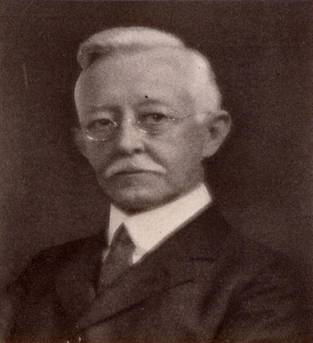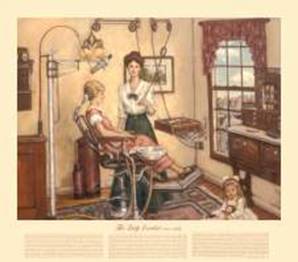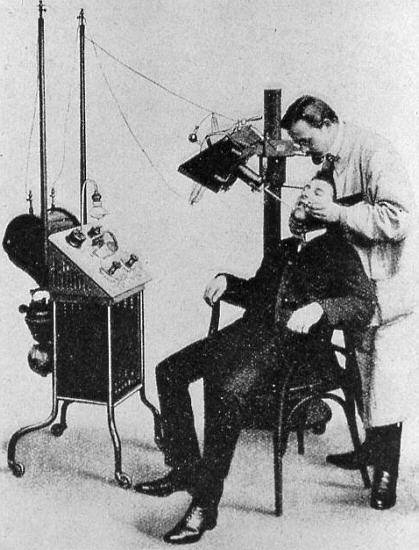
SOCIAL IMPACT ON DENTISTRY (DATES TO KNOW)
Certifications that were recognized and established during these years:
PART II: EVOLUTION OF THE DENTAL ASSISTANT

DR. C. EDMUND KELLS
DR. C. EDMUND KELLS (1887)
Had a huge impact on the profession of dentistry and dental assisting:

When commercially produced electricity become available, C.E Kells built an electrical control panel, to which he attached an electric dental drill. Today we strongly discourage using the term "dental drill" and instead use the term "dental handpiece". Whatever term you may use, Kells technology is still used in this century, with a few updates. Each time you have decay removed from a tooth and a filling place, a dental handpiece is used. Currently, there is no substitute for the dental handpiece, though there are other devices used for composite fillings, and lasers are being used more and more as their capabilities are increasingly defined.

Considered Dr. C. Edmond Kells greatest contribution to dentistry was the application of x-ray photography, or radiography. In early 1896, Kells read about the discovery of the x-ray by a German physicist named Wilhelm Conrad Roentgen. Kells ordered the needed equipment to build his own x-ray machine. Buying large sheets of x-ray film, which he then cut down to the proper size and wrapping the film in thin rubber he was able to keep the film dry inside the mouth. Using modeling compound to make an x-ray film holder he created a way to steady the film inside the patient's mouth, without using a person's fingers to hold the film in place.

Using his dental assistant as his test subject, and though unsure of how long it took to expose a film, he became the first to take a dental x-ray on a live patient. In July of 1896 just eight months after Roentgen's discovery of x-ray, Kells demonstrated the use of the radiography in dentistry to the Southern Dental Association.
At age 40, when Kells first began his work with x-rays, he was unaware of the unseen danger of cumulative doses of radiation. He often held the films in place with his own fingers. By age 50, he had developed cancer in his right hand. Over the next 20 years, Kells endured 42 operations eventually losing his hand, his arm, and his shoulder. On May 7, 1928, at age 72, he committed suicide - due to great suffering.
CERTIFICATION AND LISCENSING
THE COMMISSION IN DENTAL ACCREDITATION:
The Commission in Dental Accreditation's function is to accredit dental schools (for assisting, hygiene, and lab tech's) and education programs. By consulting in continued education program development they are instrumental in ensuring the accreditation standards are met. Every seven years accreditation of education programs is renewed. In fact, next year, the LCC dental assisting program will go through the accreditation process again, as seven years have passed since their last accreditation.
DENTAL ASSISTING NATIONAL BOARD (DANB):
DANB is responsible for administering the Certified Dental Assistant (CDA) examination. DANB offers 3 pathways for credentialing and assumes responsibilities for certification, independent of American Dental Assistant Association (ADAA). The General Chairside, RHS (Radiation Health and Safety), and ICE (Infection Control Exam) component examinations make up the Certified Dental Assistant (CDA) examination. Successful completion of these exams allows the dental assistant to use the title CDA and EFDA (Expanded Functions Dental Assistant).
STATE OF OREGON :
In the state of Oregon a Dental Assistant may hold the following certifications: EFDA, EFODA (Expanded Functions Orthodontic Dental Assistant), Sealants, Soft Reline (of dentures).
The Business Office personnel may hold the following certifications: Practice Management Specialist, Computer Program Specialist
STATE CREDENTIALING :
Each states credentialing varies. To find out what duties are legal in the state a person chooses to practice in, they must go to, call, or visit online the state's Board of Dentistry.
At the Board of Dentistry in each state the "Dental Practice Act" (which each of you should have picked up from my office on the first week of school) contains and outlines the rules and laws that govern the different members of the dental team. For instance, if you wanted to know whether a dental assistant in Texas is allowed to place a Rubber Dam, you would look in the Dental Practice Act for that state, find the section for Dental Assistants, and look up the information there. Most states have the Dental Practice Act online, at the Board of Dentistry site. Something you will each find very helpful as you begin to research the data necessary for your final paper.
DENTAL ASSISTANT LITERATURE :
Textbooks written for the dental assistant.
1955 - The Dental Assistant - by Dr. Bauer : The first comprehensive book for the dental assistant.
1969 - Dental Practice Management - by Ann Ehrlich: Created for the dental business office.
1976 - Modern Dental Assisting - by Torres and Ehrlich A major book used in Dental Assisting Programs, including here at LCC.
JOB SOURCES FOR THE DENTAL ASSISTANT
Private Dental Offices, Dental Schools, Dept Store Clinics, Armed Forces, Dental Suppliers, Public/State and Fed. Clinics, Hospitals, Insurance Companies, Teaching.